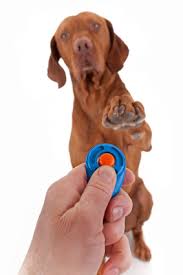 Marker training is simply a communication system between dog and handler. It is based on the principles of classical and operant conditioning. The general concept is to use classical conditioning to pair an audible stimulus (a sound) with a high value reward. Once that sound becomes a conditioned reward, we utilize the four quadrants of operant conditioning to teach cause and effect. The goal of marker training is to form an association between a behavior and a consequence, which can be either positive or negative.
Marker training is simply a communication system between dog and handler. It is based on the principles of classical and operant conditioning. The general concept is to use classical conditioning to pair an audible stimulus (a sound) with a high value reward. Once that sound becomes a conditioned reward, we utilize the four quadrants of operant conditioning to teach cause and effect. The goal of marker training is to form an association between a behavior and a consequence, which can be either positive or negative.
The first step is to develop our reward marker. Classical conditioning, or Pavlovian learning, is a process created by pairing a audible stimulus to a primary reward. In the case of marker training, we are going to pair a high value food reward with a sound, whether it is a word such as “yes” or a click from a clicker. Ivan Pavlov stumbled upon this system, and through his experiments, he found that when pairing a sound with the food, he could turn the sound alone into a reward. We call this charging the mark.
Charging the mark is accomplished by making the sound then delivering a reward. In our case, we will use the word “yes”. Through repetition, the dog learns that every time he hears the sound, the mark, a high value food reward will follow. Eventually, you will be able to say your mark and the dog will have a physical response. However, you will never go completely away from pairing it with a reward. An easy way to look at it is by thinking of this as a cookie jar. Every time you say “yes” and pair it with a reward, you are putting a cookie in the jar, and every time you simply use your “yes” marker without a reward, you are taking a cookie out of the jar.
No matter what anyone ever tells you, dogs do things for themselves. Dogs don’t do things to make you feel good. They do things to make themselves feel good. They do things because they are motivated towards feeling comfortable in addition to doing things that eliminate feeling discomfort. This is a pretty profound concept, and one that pet owners often miss. Pet owners or new dog trainers are often led to believe that dogs will eventually do things to make their owner feel good. The reality is that this is seldom, if ever, the case.
This is where the next step comes into play. Now that we have our markers charged, we can utilize operant conditioning to add a cause and effect into our communication system. The key to operant conditioning is to teach a dog that when he or she performs a behavior that we like, they get a reward that makes them feel good. Failure to perform the correct behavior would result in some form of consequence, either no reward or adding in a punishment.
There are four quadrants of learning, and this is where things may seem a bit complicated at first. The four quadrants are positive reinforcement, negative reinforcement, positive punishment and negative punishment. Positive means adding something to the equation, negative means taking something away, reinforcement means that the behavior should continue, and punishment means the behavior should stop. In simple terms, positive reinforcement would be our classically conditioned “yes” marker or reward. This is because you are adding the reward and you want the behavior to continue.
Ed Frawley
